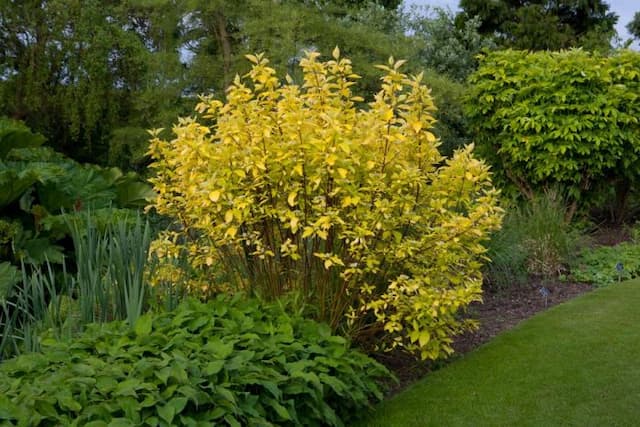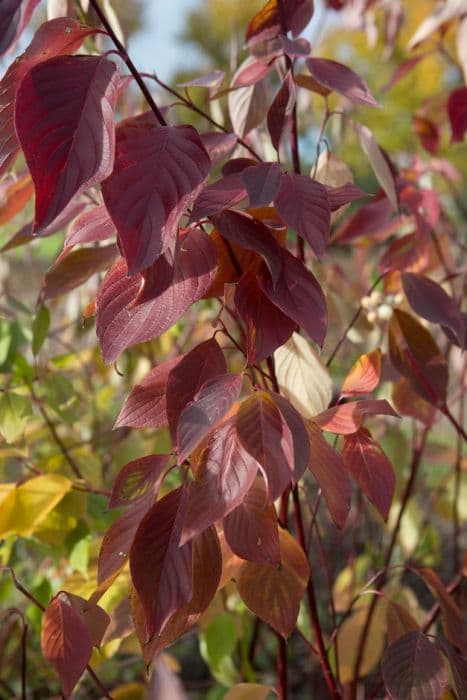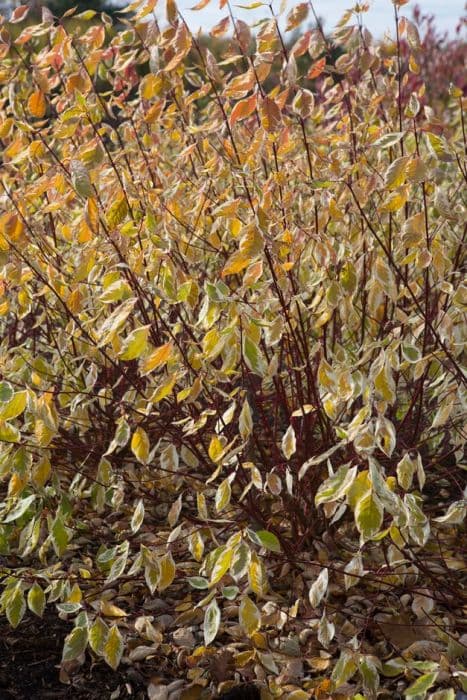Tatarian Dogwood Cornus alba 'Kesselringii'

ABOUT
Cornus alba 'Kesselringii', also known as the black stemmed dogwood, is a striking ornamental shrub known for its distinctive bark and foliage. During the growing season, its leaves are a lush green, sometimes with a whitish tinge, presenting a bright and fresh appearance. As the seasons change, the leaves transform to a bold red or purple, adding a splash of color to the landscape. One of the most notable features of the black stemmed dogwood is its bark. In contrast to the green foliage, the mature stems reveal a deep blackish-purple color which provides a stunning visual interest, especially in the winter months when the leaves have fallen. This creates a stark and beautiful silhouette against the often snowy backdrop. The plant also produces clusters of small, creamy-white flowers in the spring, which stand out well against the dark foliage. After the flowering season, these are replaced by clusters of blue-white berries that are both attractive to the eye and a food source for local birdlife. The black stemmed dogwood is a multi-stemmed shrub, with branches spreading outwards from the base, creating a full and bushy habit. Its twigs are finer and also have a dark coloration, making them a nuanced compliment to the main stems. In summary, the black stemmed dogwood is valued for its dark-hued stems, seasonal leaf color changes, white spring flowers, and blue-white berries, all of which contribute to its popularity as an ornamental garden choice.
About this plant
 Names
NamesFamily
Cornaceae.
Synonyms
Tatarian Dogwood, Kesselring's Dogwood.
Common names
Cornus alba 'Kesselringii'.
 Toxicity
ToxicityTo humans
The Tatarian Dogwood is generally not considered highly toxic to humans. While not commonly eaten, ingestion of large quantities of its parts, especially the berries, could potentially cause mild stomach upset. However, there are no severe symptoms of poisoning expected from the Tatarian Dogwood. It's always advisable to avoid eating parts of ornamental plants due to potential individual sensitivities.
To pets
The Tatarian Dogwood is also not known to be highly toxic to pets. If a pet ingests parts of this plant, such as leaves or berries, they might experience mild gastrointestinal discomfort, including vomiting or diarrhea. It is unlikely to cause severe poisoning, but it is still recommended to discourage pets from chewing on the plant and to monitor them for any signs of illness after ingestion.
 Characteristics
CharacteristicsLife cycle
Perennials
Foliage type
Deciduous
Color of leaves
Varies
Flower color
White
Height
5-6 feet (1.5-1.8 meters)
Spread
5-6 feet (1.5-1.8 meters)
Plant type
Shrub
Hardiness zones
2-7
Native area
Asia
Benefits
 General Benefits
General Benefits- Ornamental Value: Cornus alba 'Kesselringii', also known as Tatarian Dogwood, has striking dark purple-black branches that stand out in the winter landscape, especially when contrasted with snow.
- Seasonal Interest: It provides year-round interest with white flowers in spring, variegated green foliage in summer, and bright red berries and autumn leaves.
- Supports Wildlife: The berries of the Tatarian Dogwood are a food source for birds and other wildlife during the fall and winter months.
- Erosion Control: The plant can be used in stabilizing soil on slopes and banks, thus helping to prevent erosion.
- Privacy and Screening: With its dense growth habit, it can be used as a hedge or screen to provide privacy from neighbors or unsightly views.
- Adaptability: It is adaptable to a range of soil types, pH levels, and urban conditions, making it a versatile choice for various landscapes.
- Low Maintenance: Once established, Tatarian Dogwood requires minimal care and is relatively low maintenance compared to other shrubs.
- Hardiness: It is hardy and can survive in cold climates, making it suitable for northern gardens.
 Medical Properties
Medical PropertiesThis plant is not used for medical purposes.
 Air-purifying Qualities
Air-purifying QualitiesThis plant is not specifically known for air purifying qualities.
 Other Uses
Other Uses- Cornus alba 'Kesselringii', also known as red-barked dogwood, can be used to create natural fencing or boundaries due to its dense foliage and quick growth habit.
- The wood of red-barked dogwood is strong for its weight and has been used historically to make small tool handles or for intricate carving work.
- In winter, the vibrant dark purple or blackish branches provide striking contrast in the garden, which can be used to enhance the visual appeal of winter landscapes.
- Its branches are often harvested and used in floral arrangements and decorative wreaths for their stunning color and structure.
- The dense foliage provides habitat and cover for wildlife, especially birds that may nest among the branches.
- Young stems can sometimes be utilized in basket weaving or crafting due to their flexibility and strength when soaked.
- During fall, it offers attractive foliage that can be appreciated for its aesthetic value and used to enhance autumn-themed garden designs.
- In educational gardening, red-barked dogwood can serve as a tool for teaching about seasonal changes due to its year-round interest and variety in color and texture.
- This plant can be used in erosion control projects as its root system helps stabilize soil, especially on slopes or riverbanks.
- As a source of dense shade, it can be strategically planted to provide natural cooling in garden seating areas or over delicate underplantings.
Interesting Facts
 Feng Shui
Feng ShuiThe Tatarian Dogwood is not used in Feng Shui practice.
 Zodiac Sign Compitability
Zodiac Sign CompitabilityThe Tatarian Dogwood is not used in astrology practice.
 Plant Symbolism
Plant Symbolism- Transformation: The Cornus alba 'Kesselringii', also known as the Black Stem Dogwood, undergoes a striking change through seasons, with its bright red or purple foliage in fall and stark black stems in winter, symbolizing the idea of transformation and adaptability through different phases of life.
- Protection: As a plant that stands out in the starkness of winter, the Black Stem Dogwood is often associated with protection, providing a visual safe haven amid the less colorful winter landscape and symbolizing the concept of enduring through harsh conditions.
- Purity: The white flowers of the Black Stem Dogwood can symbolize purity and innocence. In some cultures, white flowers are often associated with cleanliness and the wiping away of negative thoughts or experiences.
- Hope: With its early blooms and the first signs of life after a long winter, the Dogwood is seen as a beacon of hope and a reminder that life continues and spring will return.
- Resilience: The ability of the Black Stem Dogwood to withstand cold and to grow in a variety of conditions symbolizes resilience, the capacity to recover quickly from difficulties or to adjust easily to change.
 Water
WaterTatarian Dogwood should be watered deeply once a week, with each watering session consisting of about 1 to 1.5 gallons of water, especially during its growing season in spring and summer. The soil should be allowed to dry out partially between waterings; moreover, in the autumn and winter, you can reduce the frequency due to slower plant growth and potential rainfall. Be cautious not to overwater, as this can lead to root rot. Always check the soil moisture by touching it a couple of inches below the surface. Adjust your watering schedule based on weather conditions and make sure the plant has well-draining soil to prevent excess water retention.
 Light
LightTatarian Dogwood thrives best in full sun to partial shade conditions, where the plant can receive at least four hours of direct sunlight daily. It's adaptable but doing well in a spot that offers morning sunlight with some afternoon shade, especially in hotter climates. The ideal location will mimic its natural habitat, providing a balance of light exposure to encourage robust growth and vibrant winter stem color.
 Temperature
TemperatureTatarian Dogwood can tolerate a wide range of temperatures, typically from a low around -30°F to highs of 90°F. However, the ideal temperature for this ornamental shrub ranges between 60°F and 75°F. It is hardy and capable of withstanding frost but does best when extreme temperatures are avoided.
 Pruning
PruningTatarian Dogwood is often pruned to maintain its striking stem color, which is most vibrant on new growth. It's best to prune in late winter or early spring before new leaves emerge. Cut back one-third of the oldest stems to the base to encourage new growth, and shape as desired. Pruning should be done yearly for maintaining plant health and appearance and to prevent overcrowding.
 Cleaning
CleaningAs needed
 Soil
SoilThe Red Twig Dogwood prefers organically rich, well-draining, moist soil with a pH of 5.5 to 7.5. A blend of garden soil, compost, and peat moss can provide the optimum growing medium.
 Repotting
RepottingRed Twig Dogwoods are usually not repotted as they are outdoor shrubs; rather, they may require transplanting every few years if outgrowing their location or for propagation.
 Humidity & Misting
Humidity & MistingThe Red Twig Dogwood tolerates a wide range of humidity levels and does well in average outdoor conditions without requiring specific humidity adjustments.
 Suitable locations
Suitable locationsIndoor
Provide bright light and moist soil; not ideal for indoor growth due to size.
Outdoor
Plant in moist, well-drained soil with full sun to partial shade.
Hardiness zone
2-7 USDA
 Life cycle
Life cycleCornus alba 'Kesselringii', commonly known as Tartarian Dogwood, begins its life as a seed that requires stratification to break dormancy. Upon sprouting in spring, the seedling grows rapidly, developing into a multi-stemmed shrub. The plant enters a vegetative state where it produces characteristic dark purple or black stems and oval green leaves that turn red in fall. By late spring to early summer, it flowers, bearing small white blooms that attract pollinators. Following the flowering stage, the plant produces small white or blue-tinted berries which are dispersed by birds, facilitating the propagation of the species. Over the years, the shrub can be maintained through pruning in late winter to encourage colorful stem growth, and it eventually reaches a mature phase where growth slows but the cycles of flowering and berry production continue annually.
 Propogation
PropogationPropogation time
Late Winter-Early Spring
The Cornus alba 'Kesselringii', commonly known as Tatarian dogwood, is often propagated through hardwood cuttings. This process is best performed during the plant's dormancy period in late fall or winter. A segment of a healthy, mature stem that has grown in the previous year is selected and cut into lengths of 6 to 9 inches (about 15 to 23 centimeters), ensuring each cutting has at least two or three sets of nodes. The lower end of the cutting is dipped in a rooting hormone to encourage root development and then planted in a well-drained soil mix, with the lower third of the cutting buried in the soil. Adequate moisture is maintained until roots have developed, after which the new Tatarian dogwood plant can be transplanted to a permanent location.

![Dogwood [Baton Rouge]](/_next/image?url=https%3A%2F%2Fplants-admin.emdemapps.com%2Fimages%2Fplants%2F%2Fimages%2F604b59cf0fefd.png&w=640&q=75)


![Dogwood [Ivory Halo]](/_next/image?url=https%3A%2F%2Fplants-admin.emdemapps.com%2Fimages%2Fplants%2F%2Fimages%2F604b535cbcb9a.png&w=640&q=75)




![Dogwood [Venus]](/_next/image?url=https%3A%2F%2Fplants-admin.emdemapps.com%2Fimages%2Fplants%2F%2Fimages%2F604b58a531da1.png&w=640&q=75)